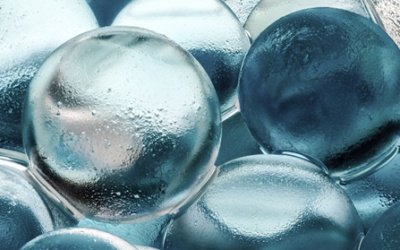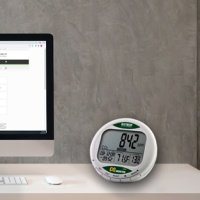Instrument Choice Experiment: How to Make an Edible Water Bottle

The Science Behind the Experiment
Sodium alginate is a food product derived from brown algae (seaweed). The compound is a structural polymer that helps the plant build its cell walls.
Sodium alginate has a wide variety of commercial applications. It's highly likely you have already ingested or used it in some way! Here are some examples of its uses.
- Food: Thickening, gelling, the foaming of foods and spherification (the latter being the method we will demonstrate when making edible bottles).
- Pharmaceutical: Preparations such as Gaviscon.
- Medicine: Often found in impression making materials for dental, prosthetic or another casting.
- Other: Fire and waterproofing fabrics, as well as paint and dye thickeners.
When sodium alginate comes into contact with a solution containing calcium ions, the calcium attaches to the polymer, creating a flexible, soft and gelatinous layer at the junction of the two solutions. The longer sodium alginate remains in contact with calcium ions, the firmer the texture becomes. It is possible to manipulate this mixture for the spherification of liquid or semi-liquid substances – something we will exploit to form our edible drink bottles.
A vital nuance when performing spherification is your choice of liquid. Two factors to monitor when performing straightforward spherification are pH and calcium content. When pH is too low or when the liquid has excess calcium ions present, spherification may not work correctly. There are workarounds and other methods to get results from a less-than-optimal blend. Still, your best chance of successfully creating a water bottle using the technique deployed in our simple experiment is to ensure the liquid you choose has a low calcium value and a pH higher than pH 4.
The Experiment
Here is how to make edible water spheres at home using two easy-to-find ingredients, plus water.
Materials Used
- 5 cups of water (1.25L) plus extra for the rinsing water bath
- Sodium Alginate (1 gram)
- Calcium Lactate (5 grams)
- Three medium-sized bowls
- Hand mixer or blender
- Slotted spoon
- pH meter (Essential if 'bottling' liquids using this method with an unknown pH); and
- A Spoon - the size of which will determine the size of your edible bottle.
Method
- In one of the medium bowls, add 1 gram of sodium alginate to 1 cup of water.
- Thoroughly combine the water and sodium alginate using the hand mixer. Note: try not to overmix as this will introduce bubbles.
- Leave the mixture to sit for 15 minutes, during which time the liquid will turn from white to clear, and feel slimy to the touch.
- Wait 15 minutes before using a second medium bowl and a handheld blender to completely dissolve 5 grams of calcium lactate in 4 cups of water.
- When you are sure the calcium lactate has dissolved, use the standard spoon to scoop up some sodium alginate solution and gently place this into the calcium lactate. The sodium alginate will form into spherical balls where it meets the calcium lactate, trapping the water within.
- Repeat, and each time ensure the spheres do not touch, as they may stick.
- Leave the spheres in the calcium lactate solution for three minutes, stirring occasionally. The longer the sodium alginate spends in the calcium lactate solution, the thicker and stronger the coating surrounding the trapped water will become. For firmer 'edible bottles', leave the sodium alginate longer than three minutes.
- Use your slotted spoon to remove the spheres from the calcium lactate solution and place them in a water bath using the third, medium-sized bowl. This step will rinse your edible water bottles, stopping the reaction.
- Your water bottles are now complete. Now take a bite to extract the water, then chew and consume the coating. Enjoy!
Results
When the sodium alginate mix came into contact with the calcium lactate solution, the immediate formation of spheres was evident.
Conclusion
Our experimental method produces edible, 100%, biodegradable, gel-like drink bottles for anyone who is environmentally conscious and on the move. Similar edible bottles were consumed during the 2019 London Marathon and have become increasingly popular for similar events ever since. Try them yourself.
*********************************************************************************
Want more information on this experiment? Speak with an Instrument Choice Scientist! We're here to help! Call 1300 737 871 or email [email protected].

Also interesting
The Instrument Choice Team of Scientists regularly reviews new and popular products, so when you need that perfect scientific instrument for your application, you can make more informed decisions.
This product review gives an overview of the popular Extech CO200 Desktop Indoor Air Quality CO2 Monitor. This market-leading scientific instrument offers a range of user-friendly features that make monitoring CO2 levels indoors a breeze.
Get all the features, specifications, benefits, and ideal applications of the Extech CO200 CO2 Monitor.

Are you looking for a standalone Rainfall Gauge? It can be challenging to select the best for your application because there are so many choices. For that reason, the Instrument Choice Scientists have been busy evaluating the current crop of gauges. Considering both technical performance and customer feedback, they have selected the five best Rainfall Gauges of the year.

